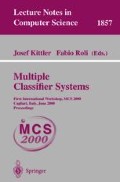Abstract
Ensemble methods are learning algorithms that construct a set of classifiers and then classify new data points by taking a (weighted) vote of their predictions. The original ensemble method is Bayesian averaging, but more recent algorithms include error-correcting output coding, Bagging, and boosting. This paper reviews these methods and explains why ensembles can often perform better than any single classifier. Some previous studies comparing ensemble methods are reviewed, and some new experiments are presented to uncover the reasons that Adaboost does not overfit rapidly.
Access this chapter
Tax calculation will be finalised at checkout
Purchases are for personal use only
Preview
Unable to display preview. Download preview PDF.
Bibliography
Ali, M., & Pazzani, M.J. (1996). Error reduction through learning multiple descriptions. Machine Learning, 24(3), 173–202.
Bauer, E., & Kohavi, R. (1999). An empirical comparison of voting classification algorithms: Bagging, boosting, and variants. Machine Learning, 36(1/2), 105–139.
Blum, A., & Rivest, R.L. (1988). Training a 3-node neural network is NP-Complete (Extended abstract). In Proceedings of the 1988 Workshop on Computational Learning Theory, pp. 9–18 San Francisco, CA. Morgan Kaufmann.
Breiman, L. (1996). Bagging predictors. Machine Learning, 24(2), 123–140.
Cherkauer, K.J. (1996). Human expert-level performance on a scientific image analysis task by a system using combined artificial neural networks. In Chan, P. (Ed.), Working Notes of the AAAI Workshop on Integrating Multiple Learned Models, pp. 15–21. Available from http://www.cs.fit.edu/imlm/.
Dietterich, T.G. (2000). An experimental comparison of three methods for constructing ensembles of decision trees: Bagging, boosting, and randomization. Machine Learning.
Dietterich, T.G., & Bakiri, G. (1995). Solving multiclass learning problems via error-correcting output codes. Journal of Artificial Intelligence Research, 2 263–286.
Freund, Y., & Schapire, R. E. (1995). A decision-theoretic generalization of on-line learning and an application to boosting. Tech. rep., AT&T Bell Laboratories, Murray Hill, NJ.
Freund, Y., & Schapire, R.E. (1996). Experiments with a new boosting algorithm. In Proc. 13th International Conference on Machine Learning, pp. 148–146. Morgan Kaufmann.
Hansen, L., & Salamon, P. (1990). Neural network ensembles. IEEE Trans. Pattern Analysis and Machine Intell., 12, 993–1001.
Hornik, K., Stinchcombe, M., & White, H. (1990). Universal approximation of an unknown mapping and its derivatives using multilayer feedforward networks. Neural Networks, 3, 551–560.
Hyafil, L., & Rivest, R.L. (1976). Constructing optimal binary decision trees is NP-Complete. Information Processing Letters, 5(1), 15–17.
Kolen, J.F., & Pollack, J.B. (1991). Back propagation is sensitive to initial conditions. In Advances in Neural Information Processing Systems, Vol. 3, pp. 860–867 San Francisco, CA. Morgan Kaufmann.
Kwok, S.W., & Carter, C. (1990). Multiple decision trees. In Schachter, R. D., Levitt, T.S., Kannal, L.N., & Lemmer, J.F. (Eds.), Uncertainty in Artificial Intelligence4, pp. 327–335. Elsevier Science, Amsterdam.
Neal, R. (1993). Probabilistic inference using Markov chain Monte Carlo methods. Tech. rep. CRG-TR-93-1, Department of Computer Science, University of Toronto, Toronto,CA.
Parmanto, B., Munro, P.W., & Doyle, H.R. (1996). Improving committee diagnosis with resampling techniques. In Touretzky, D.S., Mozer, M.C., & Hesselmo, M.E. (Eds.), Advances in Neural Information Processing Systems, Vol. 8, pp. 882–888 Cambridge, MA. MIT Press.
Raviv, Y., & Intrator, N. (1996). Bootstrapping with noise: An effective regularization technique. Connection Science, 8(3–4), 355–372.
Ricci, F., & Aha, D.W. (1997). Extending local learners with error-correcting output codes. Tech. rep., Naval Center for Applied Research in Artificial Intelligence, Washington, D.C.
Schapire, R.E. (1997). Using output codes to boost multiclass learning problems. In Proceedings of the Fourteenth International Conference on Machine Learning, pp. 313–321 San Francisco, CA. Morgan Kaufmann.
Schapire, R.E., Freund, Y., Bartlett, P., & Lee, W.S. (1997). Boosting the margin: A new explanation for the effectiveness of voting methods. In Fisher, D. (Ed.), Machine Learning: Proceedings of the Fourteenth International Conference. Morgan Kaufmann.
Schapire, R.E., & Singer, Y. (1998). Improved boosting algorithms using confidence-rated predictions. In Proc. 11th Annu. Conf. on Comput. Learning Theory, pp. 80–91. ACM Press, New York, NY.
Tumer, K., & Ghosh, J. (1996). Error correlation and error reduction in ensemble classifiers. Connection Science, 8(3–4), 385–404.
Author information
Authors and Affiliations
Rights and permissions
Copyright information
© 2000 Springer-Verlag Berlin Heidelberg
About this paper
Cite this paper
Dietterich, T.G. (2000). Ensemble Methods in Machine Learning. In: Multiple Classifier Systems. MCS 2000. Lecture Notes in Computer Science, vol 1857. Springer, Berlin, Heidelberg. https://doi.org/10.1007/3-540-45014-9_1
Download citation
DOI: https://doi.org/10.1007/3-540-45014-9_1
Published:
Publisher Name: Springer, Berlin, Heidelberg
Print ISBN: 978-3-540-67704-8
Online ISBN: 978-3-540-45014-6
eBook Packages: Springer Book Archive

